LG QNED90 Reviewed at $1,799.00 (65")
Product Name: LG QNED90
Product Description: 2021 4K Mini LED TV
-
Design - 9.2/10
9.2/10
-
Video Quality - 9/10
9/10
-
Ports & Connectivity - 9.2/10
9.2/10
-
OS, Apps and Features - 9.5/10
9.5/10
-
Price / Quality - 9.1/10
9.1/10
Summary
Reviewed at $1,799.00 (65″)
Pros
- Impressive SDR and HDR brightness
- Great gaming features
- Many features
- Good price
Cons
- Blooming still visible
- Motion interpolation had a few issues
- Local dimming had slow response
- No smaller size than 65″
Cheapest Places to Buy :
*We are a reader-supported website. When you buy through links on our site, we may earn a small affiliate commission at no extra cost to you. Home Media Entertainment does not accept money for reviews.*
LG had a bit more trouble incorporating the new mini LED backlight system into their LCD offerings this year than Samsung. You see, Samsung doesn’t have any OLEDs in their yearly lineup and thus making mini LED their top performing TV type was a no brainer. On the other hand LG had a predicament. OLED was and still is a major part of their marketing plan and they couldn’t afford to release an LCD that would approach their top performing OLEDs as this would undermine their value. So they kept both but placed mini LED just under their top tier OLEDs. And in our LG QNED90 review today we will be looking the best 4K mini LED TV on offer.

By keeping all previous series and adding the new QNED one, LG has a really extensive lineup with OLED still keeping its top position, QNED taking the place of NanoCell as the best LCDs on offer from LG while NanoCell and UHD models are pushed further down the performance ladder. For 2021 LG offers four mini LED models, two 8K and two 4K ones that combine many of the characteristics we find in the other LG releases with the new mini LED backlight that is supposed to offer even greater and more precise light control over the previous FALD systems.
But let’s see the QNED90 in a bit more detail. What we actually have here is an ADS, IPS-like, panel with a 120Hz refresh rate and a mini LED backlight system along with the a7 Gen 4 AI processor which is pretty much the same we saw in our LG A1 review. As with all TVs from LG we get Dolby Atmos and Dolby Vision support, 2 HDMI 2.1 ports, a 2.2 channels audio system and webOS 6.0 which is the new 2021 version of LG’s yearly smart OS platform with all the apps and features it comes with.
The new LG QNED90 looks like it will be LG’s best 4K LED LCD TV yet but with Samsung really focusing on their own mini LED TVs, as they don’t have any OLED offerings, does the QNED90 manages to stay competitive or LG’s decision to keep the OLED series as their top performers has a negative impact on their QNED series? Let’s find out.
Design
In terms of design the QNED90 looks beautiful. One characteristic of all these new mini LED TVs is how thin they are compared to previous FALD designs and this shows. The TV is slim enough to show nicely on the wall with only about 1.2″ (3.1 cm) thickness, something that many will certainly appreciate.
Its borders are also very subtle and they don’t distract from the image itself. At the back we find all the connections placed at the right side of the panel separated into two groups while the power cable is the only one kept separated at the left. One thing that could be designed better is the attached clips for the cable management as they don’t seem to be removable meaning that if you plan on placing this on a wall these clips add slightly more depth. The only other thing we find at the back are special holes for the VESA wall mount.
The stand that comes with the QNED90 is the usual bench type style that extends almost across the entire length of the TV meaning you need a big enough furniture for it. The legs are made out of plastic but they feel sturdy enough to keep the TV stable enough. At the back they have special grooves that you can use to drive the cables and in conjunction with the special clips found at the back of the panel the QNED90 has very good cable management overall. Lastly the stand keeps the TV high enough for most soundbars to fit under it but as we always say if you do want to place one underneath make sure to measure beforehand just to be sure.
In terms of control the remote that comes with the QNED90 is the same new design we saw in all the other 2021 LG releases. The new Magic Remote 2021 seems to bring some fresh changes without changing its overall functionality. Not that the old Magic Remote was bad but after some years it really needed some upgrading. Most functions remain the same with LG’s unique pointer system, the same universal remote functionality and smart features.

What is different is the looks and to be honest we like the new one better while it seems LG decided to lower the number of available buttons but at the same time increase the dedicated ones. While before we had buttons only for Netflix and Amazon Prime now we also get Disney+, LG channels along with special buttons for both voice assistants. Also dedicated playback buttons are a thing of the past. The new Magic Remote may seem different but the changes are welcome ones and they don’t affect the overall usefulness or functionality of the remote. If only there was also a Youtube button also!
The LG QNED90 is a really nice TV overall. Very slim design, nice new remote and good build quality are the characteristics of LG’s best 4K LCD TV this year.
Video Quality
Processor technology used
The QNED90 is using the a7 Gen 4 processor which is exactly the same one we had seen in our LG A1 review and comes with plenty of features in terms of colors and image processing.
AI is the key word here as for one more year LG is heavily promoting the AI processing capabilities of these chips that use a combination of machine learning algorithms in conjunction to a huge image database in order to offer an improved overall image and superior AI upscaling.
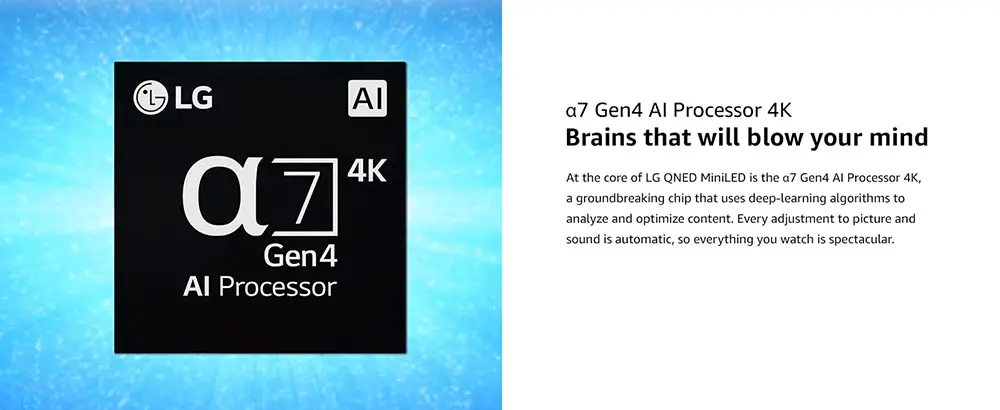
The a7 processor includes LG’s AI Picture and AI Sound suites which are a step down from the Pro variants we found in the LG C1. As such the processor automatically recognizes content genre and your ambient lighting conditions and then optimizes screen settings accordingly. It can also analyze the type of content, either it be movies, sports, animation, or standard, and automatically adjusts the picture and sound to best suit the genre.
Lastly there is AI Brightness Control which automatically adjusts tone mapping and screen brightness based on the ambient lighting conditions. The screen brightens in bright environments and darkens in darker environments to reduce halo effect and improve clarity.
Trying out lower resolution content didn’t reveal any major issues as all kinds of video content including SD, 720p, 1080p and 4K material would render nicely. Lower resolutions didn’t reveal any noticeable artifacts due to the upscaling process and it seems that the processor, as was in the previous years, is very capable in this regard.
But the a7 processor not only comes with image AI enhancements as it offers some more advanced audio features also like 5.1 up-mixing, adaptive sound control and AI acoustic tuning. But more on these in the appropriate section.
Lighting technology used
For a long time LCD TVs were plagued by mediocre backlight systems and in 2021 this is the first time we see a major step forward in this regard. So far the best backlight system to be used was a Full Array with local dimming system (FALD) but even this was very much dependent on the number of dimming zones available. The more dimming zones, the more precise light control. But this had a major impact on the final price of the TV.
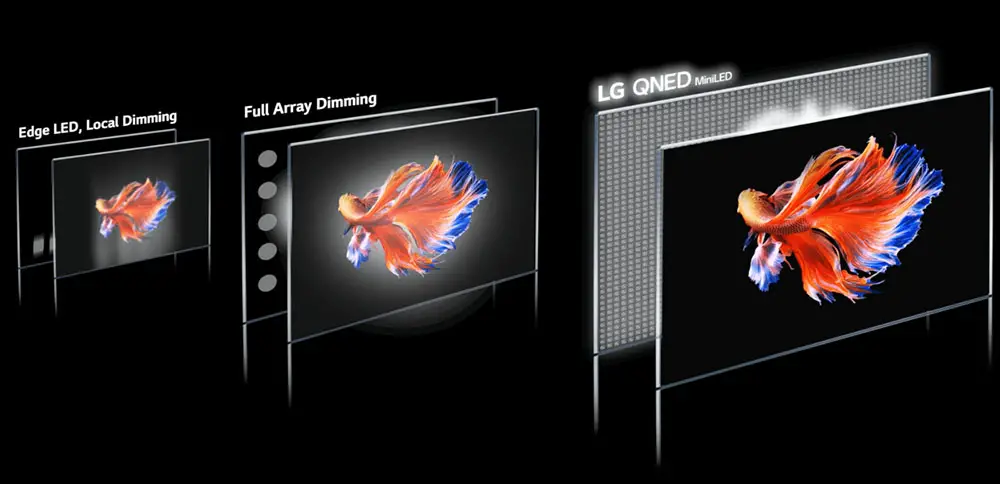
The QNED90 on the other hand is using a mini LED backlight which is similar to those we had seen in our Samsung QN85A and QN90A reviews. The major advantage of mini LED is that it is much smaller than conventional LEDs. Instead of using a lens to disperse light, and a package to fix the LED in place, the mini LED backlight has incredibly thin micro layers filled with many more LEDs. This way the backlight has much better and more precise control of the densely packed LEDs, preventing what was the most obvious disadvantage of previous LCD backlight systems, blooming.
Keep in mind that while mini LED technology is vastly superior to any other LCD backlight system so far it is not alleviating the blooming problem completely and it is still very much dependent on the number of zones that have been added to each panel along with how efficient the dimming algorithms are. The 65″ we are testing here seems to have around 1000 dimming zones, a number that was simply impossible with the previous FALD systems. Although we couldn’t confirm this, the bigger sizes usually tend to use more zones but we don’t have specific numbers for the rest of the sizes being offered.
The QNED90 had a decent local dimming but not without flaws. It seems that the algorithm handling the zones was a bit slow and as a result it felt like bright objects in a dark background would not only show the familiar blooming, but at a lesser degree than previous years to be honest, but also would leave a small light trail until the specific zones would be deactivated. This was not very apparent in real content but in some scenes with bright objects moving on a black background, like a spaceship traveling in space for example, it can be noticeable.
And while the inclusion of the mini LED system’s main feature is to primarily combat blooming and offer more precise light control it also affects the overall design of the TV making it slimmer than what we are used to see with FALD TVs that have a slightly thicker panel due to the included LED array at the back.
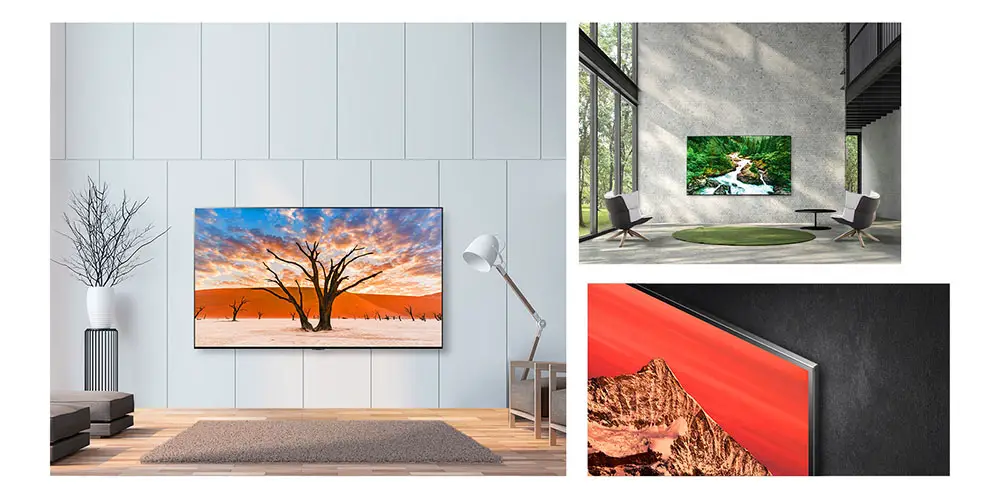
Brightness / Contrast
There may be a lot of areas where OLED technology is ahead of current LED LCD ones but if there is one area that LCD TVs still excel at, this is at their brightness output. And with the inclusion of the much better mini LED backlight we have high hopes on what the QNED90 can give us in this regard.
So in our SDR brightness over a 10% window the number we got was 874 nits which is excellent and more than enough for any SDR material out there. When it comes to HDR brightness over a 10% brightness we measured 1025 nits which is great as anything above the 1000 nits threshold is capable at very bright highlights and impressive HDR. For these measurements we used max brightness and LED Local Dimming set to high.
From the above numbers it is obvious that the mini LED offerings from LG are a step below what Samsung did with their implementation of the new system and what is happening is what we said previously. The mini LEDs that LG is offering are not on par with the ones Samsung offers, at least in terms of brightness, because LG wanted to keep their OLED models as the top performing ones so they slightly scaled them back to fit between the OLED and NanoCell series but still be worthy for consideration.
In terms of contrast the QNED90 comes with an ADS panel which is very similar to an IPS one and thus has all the same characteristics including less than average native contrast ratio. But this is where the new mini LED system comes into play as with local dimming set to high things improve vastly and contrast becomes much better overall.
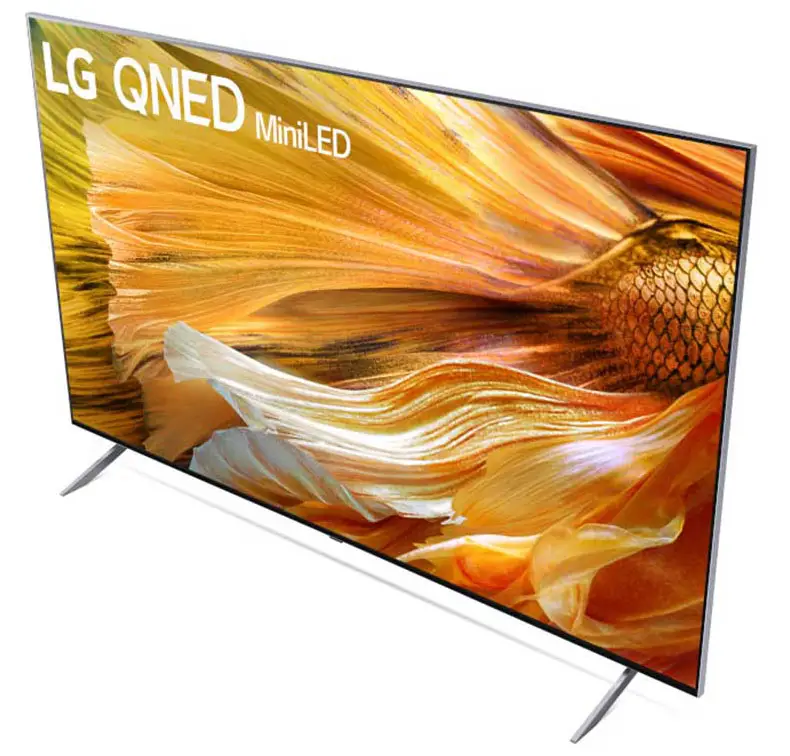
Viewing angles
The QNED90’s ADS panel being some type of IPS panel meant that in general viewing angles would be very good. LG is in general mostly using IPS panels instead of VA ones and this gives them the edge in terms of maximum viewing angles these can achieve. They still may not be as good as OLED but it’s the best you can get in terms of an LCD TV and the QNED90 follows the rest of the group.
As for the QNED90 specifically we would say that a maximum of 40 degrees angle, or slightly above that, was acceptable with little degradation in overall image quality. Anything more and the image looses a lot in terms of brightness, colors and black levels. So if you are considering to use this as a family TV you shouldn’t have any problem with various viewing positions.
HDR support
In terms of HDR support we get the usual treatment so don’t expect any surprises here. As such the QNED90 comes with support for the basic HDR10 that is needed for 4K UHD playback, it also supports the more advanced Dolby Vision which uses dynamic metadata for more accurate HDR representation and HLG that is used mostly for broadcasting.
The obvious omission is HDR10+ and we don’t see LG supporting it in the foreseeable future as this is pretty much Samsung’s territory while it seems to be also missing the Advanced HDR by Technicolor but this is hardly an omission as there was no real support for it to begin with.
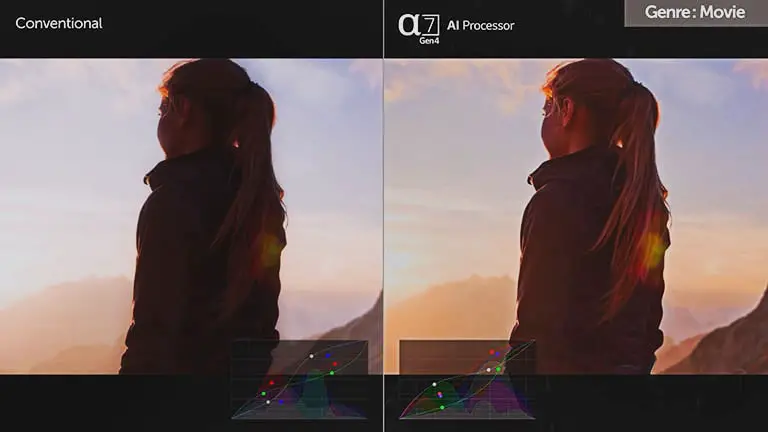
Dolby Vision IQ is making a return from last year and this basically uses an external light sensor on the body of the TV and can automatically adjust the Dolby Vision dynamic tone mapping according to the ambient light in the room and also according to the material that is displayed on screen at each moment. Obviously this can be turned off if you don’t want the TV to go ahead with such processing that can really change the final outcome of the image.
Color coverage
Let’s look at the TV’s color performance now. According to our measurements the QNED90 covers about 95% of the DCI-P3 color space which is very good. On the wider REC.2020 color space we got 74% coverage which is also great. These numbers show that the QNED90 is actually on the same level with some of LG’s OLED units that we had tested before and thus we can confirm that this TV does indeed support wide color gamut.
In terms of color gradients things looked pretty good with only some minor banding towards some darker shades but it was not very obvious and in general, compared to other similar models the QNED90 behaved extremely well. The QNED90 belongs to a new series so we have no comparison units from last year and our best bet is LG’s OLEDs that still remain their premium release. And compared to those the QNED90 passed with flying colors.
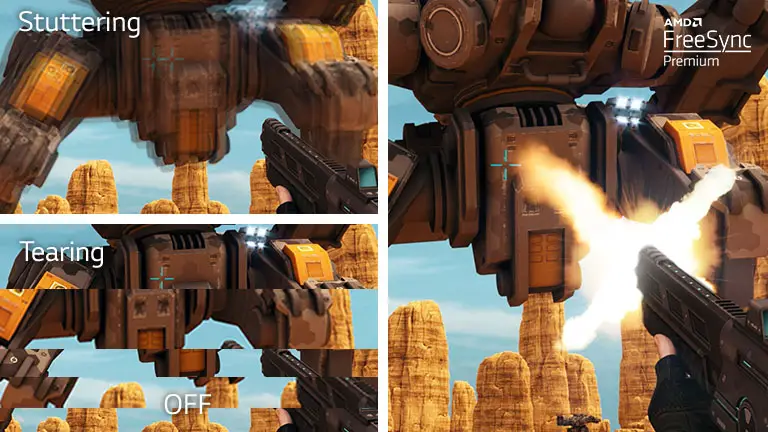
Motion performance
The QNED90 uses a native 120Hz panel and what we can say is that in terms of motion performance the QNED90 performed very good across the board. There was some cases of micro-stutter here and there depending the content on screen but overall we were very pleased with how the unit handled most of the material we threw at it including both high and low framerate videos.
The TV comes with the usual Motion Interpolation features that can smooth motion and remove blur and judder from fast camera movements. Motion interpolation handled most content with good results but obviously when there is heavy action some artifacts do show their ugly face as the TV cannot keep up. Obviously using very aggressive settings will make the familiar “Soap Opera Effect” to appear so you have to adjust the settings accordingly. Motion Interpolation can be enabled by the TruMotion setting in the menu. You can set that to user and then adjust the De-blur and De-judder sliders according to your preferences.
There is also the standard by now Black Frame Insertion (BFI) feature which basically is a motion interpolation technique that inserts a black frame between every two individual frames and this can really create much smoother motion. But while the end result is pretty good there are some downsides to this with the most obvious being the lower brightness being displayed due to the black frames. BFI can be enabled from the Motion Pro setting in the TruMotion menu.
The QNED90 comes with support for all VRR technologies including HDMI Forum VRR, AMD FreeSync and NVIDIA G-Sync making it an excellent choice for your gaming needs. All of them can be enabled in the new Game Optimizer menu that LG has created and is available in many of their 2021 models.
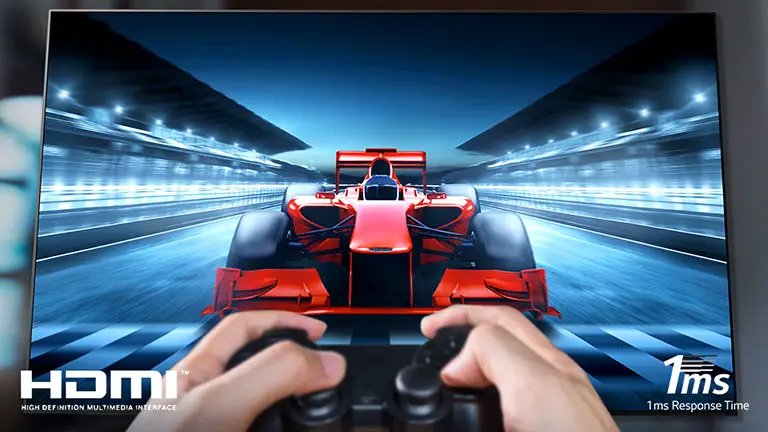
Input lag
Input lag was one aspect of the TV that we were sure we would see good numbers as it has become the norm to see low figures even from lower tier releases the last few years. The previous 2021 LG releases that we reviewed behaved similarly so the QNED90 could not be any different.
According to our testing the QNED90 was able to give us an average of 13.4ms input lag in both 1080p and 4K resolutions which is very good, even if slightly higher than what we were expecting. We have seen numbers in single digits but even this, is extremely low and enough for even the most hardcore of users. Outside of Game mode we measured an average of 128ms which is high for fast reaction games but can still be adequate for casual sessions. Lastly for high framerate content at 4K@120 the input lag was measured at 5.6ms.
We should also not forget to mention that the TV supports Auto Low Latency Mode (ALLM) that can be used with any devices that support that like the PS5 and Xbox consoles and can greatly benefit users. Once again we get HGiG Mode which is HDR Gaming Interest Group’s technology that ensures you enjoy HDR games the way that their creators and developers intended.
For some real world testing we used our PS5 connected to one of the HDMI 2.1 ports and used our F1 2021 game to see its behavior. No complaints really. The TV did great with fast response times, excellent reactions and instant rendering of all our commands. If you look for a good performing premium 4K TV the QNED90 ticks all the boxes.
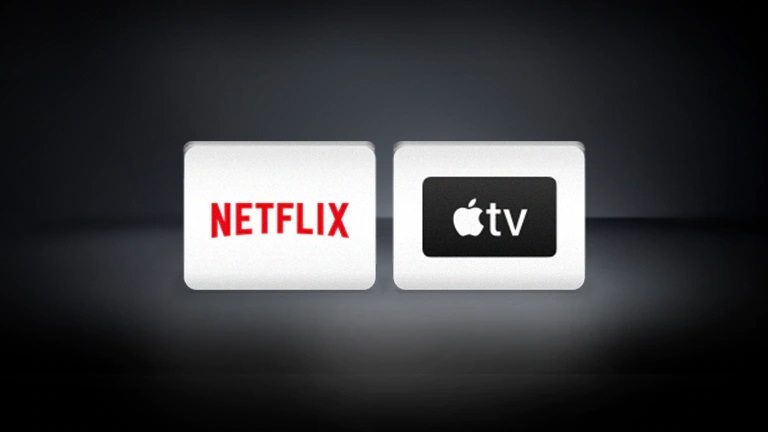
Image quality impressions
The QNED90 is a really good performing TV and certainly one of the best 4K LCD TVs LG has released so far. The new mini LED backlight has helped to minimize blooming while its other characteristics like high brightness in both SDR and HDR, nice viewing angles, good upscaling capabilities, low input lag, nice gaming features and solid motion performance place this model high in the performance ladder.
On the downsides what we can say is that blooming, although less than before, is still very much visible. Also the dimming algorithm seemed a bit slow with its reaction times while motion interpolation has a few problems here and there when things went crazy on screen. Some slight banding in the darker shades was noticeable but not always and obviously HDR10+ is missing as with everything that has the LG logo on it. In general there were not many bad things to say and this is a really impressive feat by LG.
Audio Quality
Onto the audio now and what is used in the LG QNED90 is a very similar system to the LG BX of last year as both of them not only use the same setup but the capabilities of their processors are remarkably the same. As we have said many times before with the arrival of so slim TVs there is simply not enough space to incorporate capable enough audio systems that could really create an immersive atmosphere. Manufacturers are trying to rectify this by adding more advanced software and virtual tech but if the hardware is not capable enough there is so much software can do.
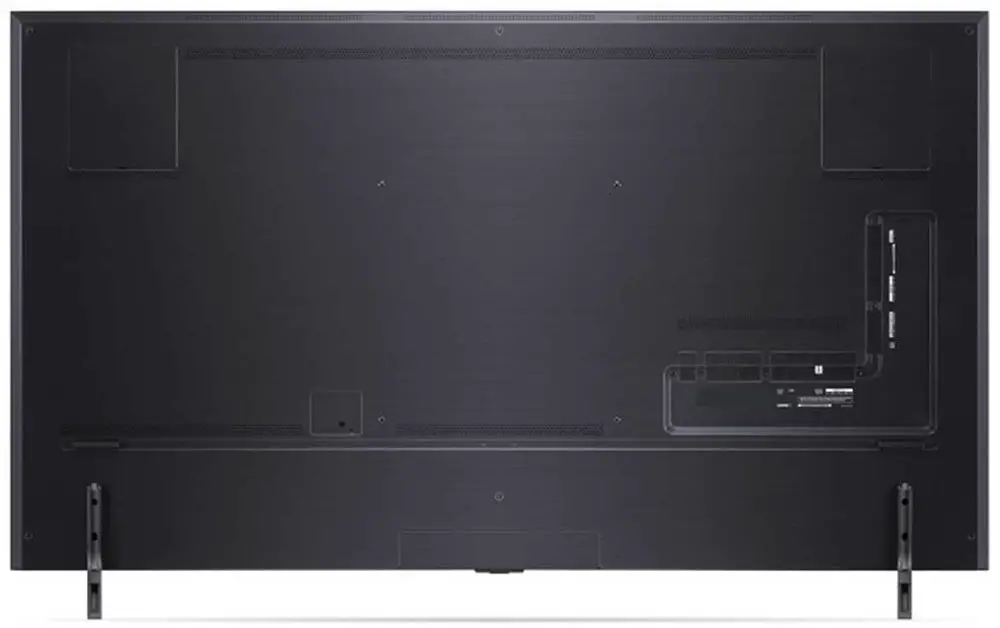
The QNED90 comes with a pretty standard 2.2 channels audio system with a total of 40 watts of power. Part of the a7 Gen 4 Processor 4K capabilities is the inclusion of AI Sound and what this does is to optimize sound by genre by analyzing audio sources depending on content type. The AI algorithm can also up-mix two-channel sound to convincingly mimic 5.1 surround sound, enhancing the quality for a better listening experience.
In addition to the above there is also Bluetooth surround ready which means that the QNED90 cannot only mimic 5.1 surround audio through virtual technology but it can really drive the up-mixed audio into two wireless, Bluetooth enabled speakers that you can use as surrounds and get much better and accurate surround activity.
And since we are talking about surround audio the TV is also capable of supporting Dolby Atmos either through some streaming service or through the HDMI eARC connection. With the included audio system don’t expect to get a real Atmos experience but nevertheless it’s good to see it being supported.
Continuing on the TV’s AI sound capabilities we get what is called Adaptive Sound Control. Whatever you’re watching either it be dramas, sports, movies, news, or music the processor recognizes it and optimizes the sound for that specific content type. As a result newsreaders’ voices will be clearer, and movie sound effects will be more vivid.
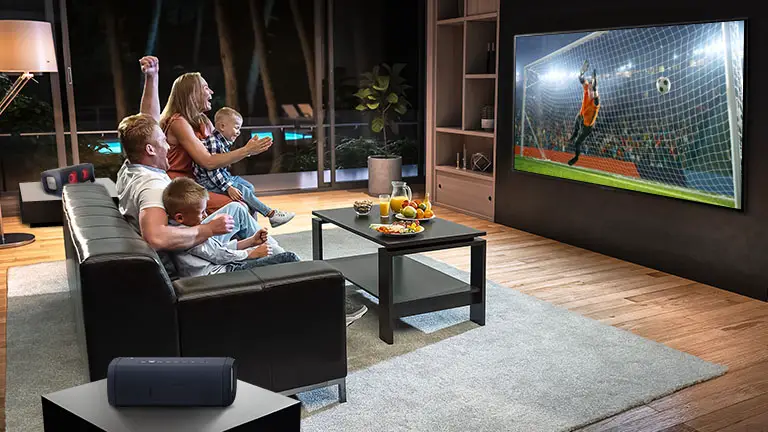
There is also AI Acoustic Tuning function and with this the TV is using the magic remote’s built-in microphone to detect the size of your room, the position of the TV, and where you’re sitting in order for the processor to tune and balance the sound to fit your space.
Lastly the TV is WiSA ready which mean it supports high fidelity 2.1 channels audio reproduction.
What we have here is the standard you should expect from LG. Good audio for casual viewing but it cannot do much to envelope you in a more cinematic bubble. For that you will have to go for a good quality soundbar or a full surround system.
Ports and Connectivity
All connections on the QNED90 are placed on the right side of the back panel of the TV separated into two groups with one looking sideways while the other looks downwards. This is actually an improvement and many previous LG units had ports looking backwards making them hard to use if you wanted to wall mount the TV.
Let’s start from the ones that look sideways and here we get a single USB port along with four HDMI ports, with HDMI 3 also getting ARC/eARC support. At the lower end there is an optical digital output. At the back we get two more USB ports, an Ethernet port, an RS-232C port and the usual antenna/cable connector.
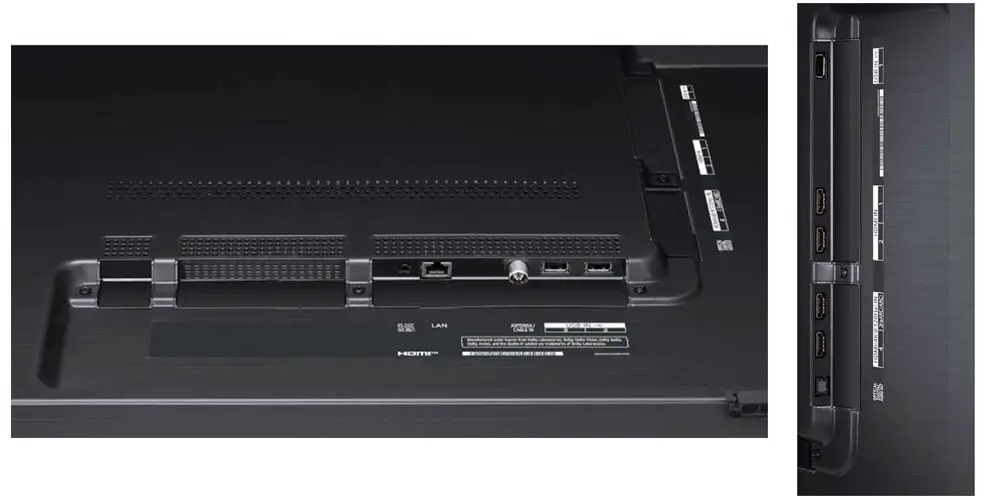
One interesting fact about the HDMI ports is that while these are HDMI 2.1 they don’t support the full 48Gbps bandwidth and instead cap at 40Gbps but this is not a big deal as having 12 bit enabled ports would go to waste as there is no panel capable of 12 bit yet. The HDMI ports being v2.1 means that they support all new and old features including 4K@120,ARC, eARC, ALLM, VRR, G-Sync, FreeSync, HFR and HDMI-CEC.
Once again there are no composite audio/video input and this is something we have noticed in general as manufacturers slowly are phasing out the analog ports in their new releases. So if you happen to have some older equipment that does not have a HDMI I think you should think twice before pulling the trigger on this one or it’s time to start updating as this will surely extend to more and more audio/video products in the future.
As for the TVs wireless capabilities we get built-in WiFi (802.11ac) along with the newer Bluetooth v5.0.
OS, Apps and Features
The mini LED backlight may be the obvious highlight in the new QNED TVs and not without reason but things have drastically changed in the software front also with the arrival of the latest webOS 6.0 which we have already seen first hand in both the LG C1 and A1 reviews we had recently. The QNED90 is not all that different and offers the same functionality so this part of our review will be very similar to our previous observations.
You see, up until last year webOS was using a single row of tiles on the lower part of the screen where everything was grouped together. Now in webOS 6.0 this has changed as the UI is taking up the whole screen and provide you with far more visual information than any of the previous versions ever did. We do get that some may prefer the old design that could still allow you to watch what was on screen but this is completely a personal preference.
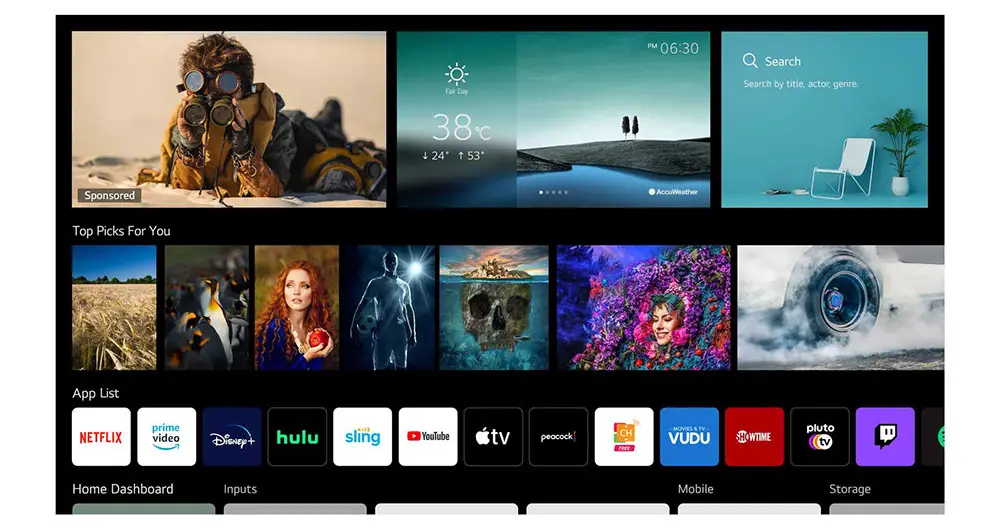
The new webOS reminded us a bit of what Google TV is doing. It seems that smart TV platforms opt for a more personalized experience now and as such the new webOS 6.0 tries to provide you with options that are tailored for your viewing habits. As such there are personalized ads, recommendations based on your viewing patterns both for streaming services and broadcasting channels and even shopping suggestions.
When you first look at the new design you will certainly feel like it’s a cluttered mess but if you spend a few minutes with it most of its architecture will dig in and you will get the hang of it fairly fast. By pressing the Home button the main webOS page opens where you still get a single row of your apps on the bottom that you can re-arrange any way you want.
On the top you get three big tiles for sponsored content, weather and time along with search. Below a single row with recommendations depending what LG’s algorithm believes you would like to watch. Under the apps row there are many more options to choose from like the Home Dashboard, broadcasting channels, shopping recommendations, Sports Alerts messages and much more.
Overall we can say that we like what LG did with the new webOS 6.0. It feels fresh although a bit more cluttered for those not interested in so much information the new UI provides. Also if you are used to the UI of the previous years it will certainly take some time to find your bearings.
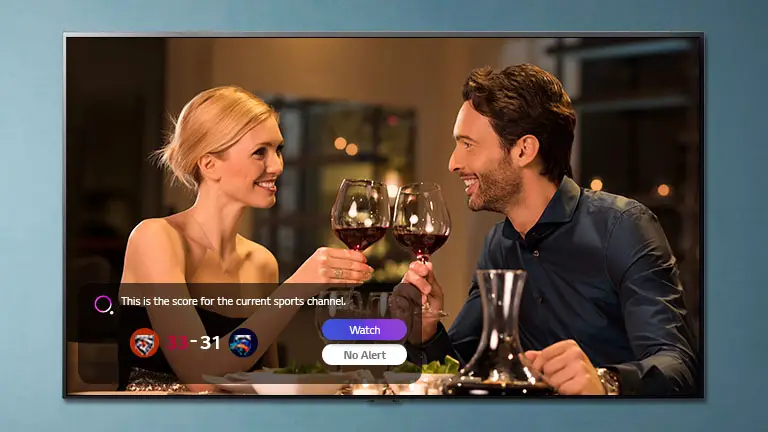
One thing that hasn’t changed in the new 2021 version of webOS is app support and as such you will find all the apps you may need with more available from the online store for downloading. All the big players are present with Netflix, Youtube, Amazon Prime, HBO, Vudu, Hulu, Google Play Movies, Disney+ and Apple TV+ just to name a few of the most notable ones.
Other available apps include Apple Airplay 2 and Apple Homekit. With Airplay 2 you can stream content from other Apple devices on your TV while HomeKit lets you control certain aspects of the TV through your mobile device.
One interesting feature that makes a comeback this year is Sports Alert. You can set your favorite team on the TV and the QNED90 will inform you when a match will be shown and in which channel while can also give you score updates and the likes. The Sports Alert feature seems to be working with the internal tuner and it gives you the ability to choose from a wide range of teams and sports. Obviously it still doesn’t include every sport and every team out there but there are plenty to choose from the list available.
And since we are talking about a smart TV platform we could not go by without mentioning voice control functionality. LG has included not only their own ThinQ AI that you can use to search for various information but also the two most used voice control platforms including Amazon Alexa and Google Assistant. By using the Magic Remotes built-in microphone you can issue your commands like search for a specific TV show or control your TVs volume and change channels. Keep in mind that the TV also has built-in microphones for a completely hands free experience.
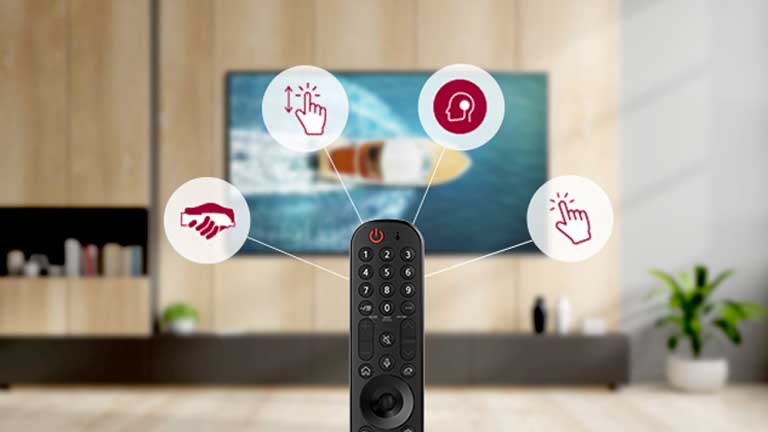
There is also mobile app support if you prefer that instead of using the included remote. LG is using their ThinQ app that is supported both by Android and iOS devices and with it you can issue some basic commands to your TV.
For another year we find what LG calls Home Dashboard which is a nice little feature that lets you have an overall look at all the connections of the TV. Although not much have changed here Home Dashboard has now been fully intergraded into the webOS 6.0 Home screen making its access faster than before.
Before closing we need to mention about the new Game optimizer feature that was added with a firmware update lately and with it you can check specific settings during gaming including fps, VRR options, colors, sound and many more. It is in a way similar to what Samsung has done and it shows that manufacturers have put a lot of effort to offer more practicality and accessibility to gamers which was to be expected with the new generation of consoles now out in the market.
The QNED90 offers the usual LG treatment for 2021. It includes everything LG has on offer for 2021 while the new UI seems like a fresh take on an already very stellar smart OS system. If you are used to previous webOS versions it may take you some time to find your bearings but once you do it will feel like second nature.
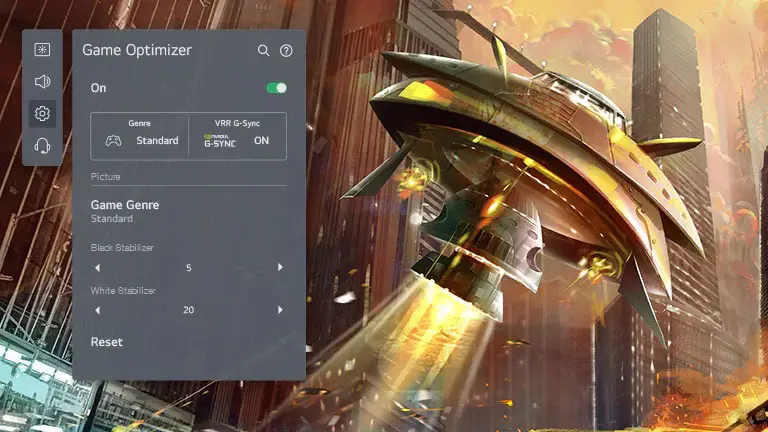
Final Thoughts
As with everyone else this is the first year that mini LED TVs make an appearance and while in Samsung’s camp things were pretty obvious when it comes to LG things were not so crystal clear. It was obvious from the beginning that LG wanted their OLED series to remain their top performers but on the other hand the inevitable comparison between Samsung’s and LG’s mini LED releases would bring LG in a tough spot. The end result finds the QNED90 somewhere in the middle to be honest.
The unit we tested really is one of the best LED LCD TVs LG has released so far. The new mini LED backlight do help with the everlasting problems of previous backlight systems but does not completely solve them as blooming is still visible while slow local dimming reaction could leave trails behind some very bright objects. Also using an IPS-like panel meant that contrast would not be so good but thankfully the local dimming greatly improves on that.
As for everything else the TV was a real nice performer. Great brightness in both SDR and HDR content, excellent upscaling capabilities, very nice viewing angles making it a good family TV proposition while it brings along the whole gaming suite from LG which means HDMI 2.1 ports, VRR, FreeSync Premium and G-Sync which if you combine with an incredibly low input lag makes the QNED90 an ideal gaming TV either you are a casual or demanding gamer.
Closing what we can say is that if you are not into OLED because you either want a brighter TV for use in a very bright room or you are still a bit afraid of the potential burn-in issues these may have then the LG QNED90 is one of the best 2021 4K LCD options for you to consider. Its capabilities makes it ideal for mixed use so either you plan on using it in a family room, in a gaming setup or just want it for your home theater the TV will surely offer you a great overall experience.
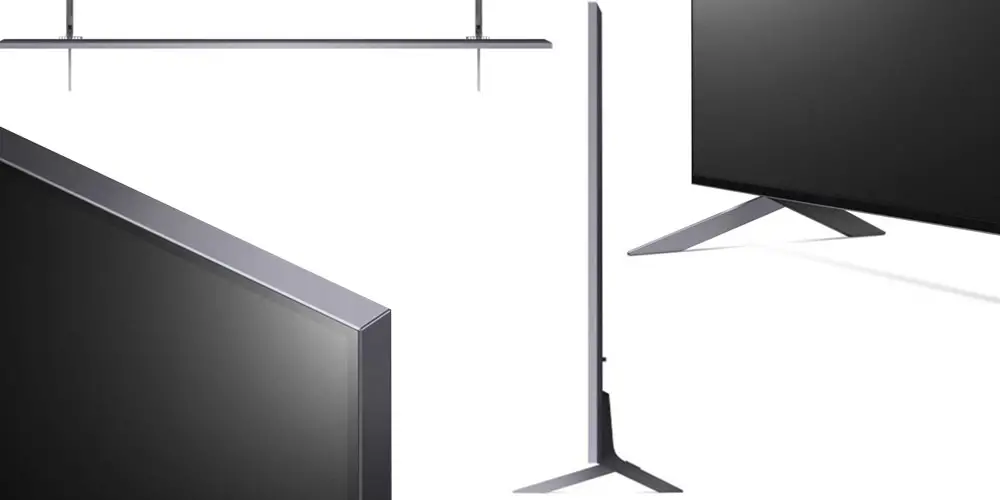
For more reviews you can check our dedicated 4K LED LCD TV reviews list or even look at our Product Reviews Table where you can find the brand and specific product you are looking for.
Cheapest Places to Buy :
*We are a reader-supported website. When you buy through links on our site, we may earn a small affiliate commission at no extra cost to you. Home Media Entertainment does not accept money for reviews.*
It was about time to see some improvements in the TV’s backlight. Especially edge LED system look very bad. I had a KS9000 and although very nice and bright TV it looked awful in very dark scenes. I was considering a FALD one but the new mini LED surely is better. Is it worth it going for one of the 8K models or it is just a resolution bump?
Hello Bernard. I would say that going for the QNED90 is the best value for money. There is literally no 8K content available and until it does these models will surely be old enough. So better look at the QNED90 which is the best 4K LCD on offer from LG at the moment and when 8K will become mainstream, if ever, then you can consider upgrading.
I was between the QNED90 and an OLED but ultimately I went for an OLED. The QNED90, as you said, still has some blooming visible. It’s not very much or very distracting, at least to my eyes, but compared to an OLED there is no comparison. Still a good choice for anyone looking for a LCD one.
Indeed OLEDs remain the best. Even with so many dimming zones it seems they cannot compete with the literally millions of zones an OLED has. Obviously there will be improvements but to get to something really close to what OLED TVs can do we will have to wait for micro LED which surely is a few good years until they become widely available.
Hello one and all,
I know the size of 65″ inch tv is, but it would help to be told what the measurement is from the bottom left to the bottom right, I’d expect this to be less that the 65″ the tv is. This could influence a purchase or getting a new cabinet for it ti stand-on.
Hello Brian. You mean how long the stand legs measure? If so the stand width is 47.8″.